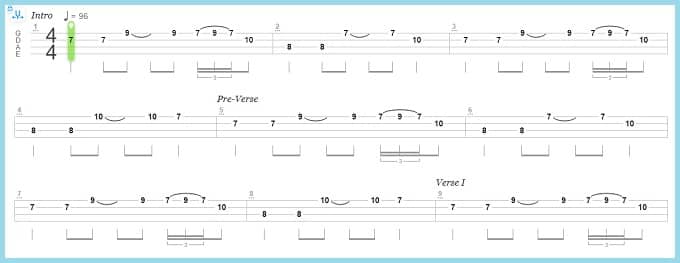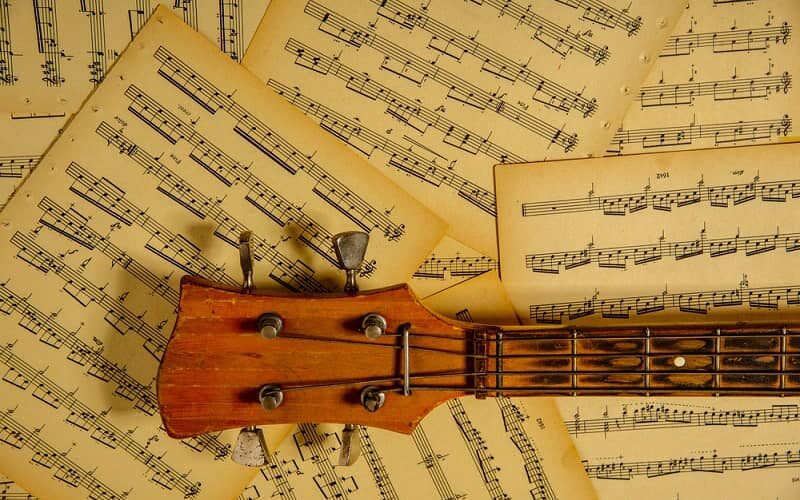Have you ever seen those mysterious numbers and lines that makeup bass tablature and wondered what it all means? Well, you’re not alone. As a beginner bassist, learning how to read tabs can feel confusing at first.
What if I told you that mastering bass tabs could be your gateway to playing your favorite songs with ease? Imagine effortlessly recreating those iconic basslines, the heartbeat of your favorite tunes.
Jump into this guide, decode bass tabs, and open the door to a world of musical opportunities. By the end, you’ll read bass tabs like a pro in no time.
Why read this article? Because here, we’ll unravel the mysteries of bass tablature, providing you with the essential skills to play your favorite songs and unleash your inner bass maestro.
Let’s get started on this melodic journey!
A Quick History of Tablature
Before we dive into the deciphering tab, let’s go over what exactly it is. Tablature (or tab for short) is a notation system that shows you what notes to play on a fretted instrument like bass, guitar, or ukulele.
Instead of the oval-shaped note heads used in standard notation, tab uses numbers to tell you what frets to press down.
Tablature has been around for centuries, dating all the way back to the lute in the Renaissance era! Its simplicity made it easy for amateur musicians to share and learn new music. Once the internet took off in the ’90s, tablature experienced a resurgence as an easy way for musicians to exchange songs online.
Nowadays tablature comes in all forms – from interactive tabs that play along with you, to text-based tabs using keyboard characters.
There are even tab books you can buy that contain popular bass lines written out. No matter what style of tab you come across, the main components stay the same.
What Does Bass Tablature Look Like?
At first glance, bass tab may look like a bunch of numbers and lines haphazardly put together. But there is a method to the madness! Here’s a breakdown of what you’re looking at:

Tab consists of horizontal lines that represent the strings on your bass. The bottom line is the lowest string (typically the E string) and the top line is your highest pitched string (typically the G string on a 4-string bass). If you’re playing a 5 or 6-string bass, you’ll have additional lines.
The numbers on each line tell you what fret to play on that string. 0 means play the open string, 1 means press down at the 1st fret, and so on. Reading from left to right shows you the order of notes to play.
Stacked or aligned vertical numbers indicate notes played together like a chord. Symbols above or below the tab give directions for techniques like slides, bends, hammer-ons, and more.
Now that you recognize the different components, let’s break down how to interpret them.
Decoding the Tab Lines
The foundation of bass tablature is the horizontal lines representing each string. Standard tuning on a 4-string bass is E-A-D-G from lowest to highest pitch. The lines follow this order:
E |-------------0--|
A |--------0-------|
D |--3--------------|
G |------------------|In this example, you would play the open E string, followed by the open A string, and end on the 3rd fret of the D string. Reading from left to right, you know what order to play the notes.
If you’re playing a 5 or 6-string bass, additional lines are added (typically B and C). But the concept remains the same – the lowest pitched string gets the bottom line in the tab.
Some tabs may label the string names on the far left side so you know exactly what tuning you’re looking at:
E |-0----------------|
A |---3--------------|
D |------5-----------|
G |-------------------|Get in the habit of checking what strings are represented before diving into the tab.
Fret Numbers Demystified
The fret numbers on each string tell you where to place your finger to produce the correct note. The concept is simple:
- 0 = Open string
- 1 = 1st fret
- 2 = 2nd fret
- And so on…
But you’ll gain flexibility by understanding the notes on your bass. For example, the 5th fret of the E string is an A note. And the 7th fret on the A string is a D note. Understanding this fretboard geography helps you learn tabs faster.
Here are a few examples of fret numbers on each string:
E |--0--|--5--|--7--|
A |--2--|--7--|--9--|
D |--5--|--9--|--0--|
G |--3--|--8--|------| Practice finding these notes on your bass before tackling tabs. The fret numbers will make more sense once your fingers get used to their location.
Stacked vs Sequential Fret Numbers
Most of the time, fret numbers are read from left to right in sequence. You simply play the notes one after another.
But you may also see fret numbers stacked vertically. This indicates to play them together like a chord:
E |--0-----------------|
A |--5--7--5-----------|
D |--7-----------------|
G |---------------------|Here you would play the open E string while also fingering the 5th fret on the A string and 7th fret on the D string simultaneously. Get ready for your fretting hand stretch!
Pay attention to whether notes are aligned vertically or written sequentially. It can completely change the sound.
Navigating Bass Tab Symbols
Along with the string lines and fret numbers, you’ll see various symbols in bass tabs that give you important instructions:
- Hammers and Pulls – Shows you to hammer-on and pull-off notes without repicking the string. This creates a smooth, legato sound. Hammer-ons (notated as ‘h’) go to higher frets, while pull-offs (notated as ‘p’) go to lower frets.
- Slides – Slanted lines show when and where to perform slides up or down the neck. Think of the slide symbol as an arrow pointing to the target note.
- Bends – Curved arrows indicate string bends, with a number telling you how many steps to bend. Releases are shown with downward angled arrows. Pre-bends have ‘pb’ notated.
- Vibrato – Wavy lines above or below a note tell you to add vibrato by shaking the string.
- Palm Muting – Dashed lines underneath the tab signify when to palm mute the strings. ‘PM’ may also be notated.
- Harmonics – Notes with ‘<‘ ‘>’ around them are harmonics. ‘A.H.’ means artificial harmonics, ‘N.H.’ for natural harmonics.
Once you memorize what each symbol means, reading the tab gets easier. Most bass tabs use standard notation symbols, but you may see some differences depending on the source.
Where to Find Good Bass Tablature Online
Now that you know how to read tablature, it’s time to find some great bass tabs to start practicing with! Here are some of the top websites for bass tabs:
- Ultimate Guitar – This popular site has a massive collection of free tabs for all instruments including plenty of bass lines. You can search by genre, artist, or song title to find what you’re looking for. Results will show you user rating levels.
- Songsterr – Offers interactive bass tabs that you can playback online and follow along to. The tabs also show rhythm, so you can see the note durations. A great site for beginners.
- StudyBass – Focusing solely on bass tabs, StudyBass provides high-quality tabs for rock, pop, metal, funk, and jazz bass lines. You can also learn about scales, techniques, and theory.
- MySongBook – This site provides official tabs for your favorite songs without aiming to be a large database. The quality of each tab is ensured by the company to be correct.
For more obscure bass lines, forums like TalkBass are great for finding user-submitted tabs. Browse the archive of over 1 million threads to see if anyone has tabbed out your desired tune.
Which Tabs Should You Choose?
When searching for bass tabs online, you’ll often find multiple versions of the same song available. All user-submitted tabs have the potential for inaccuracies or errors. How do you know which one is correct?
Here are some tips for choosing quality tabs:
- Check user ratings – The highest rated versions often provide the most accurate tabs. Sort results by rating level when possible.
- Match # of strings – Make sure the tab matches the number of strings on your bass. Don’t use a 6-string tab for a 4-string bass.
- Look for rhythm – Tabs with rhythmic notation above the tab lines are easier to follow. Interactive tabs that play the notation are even better.
- Know the source – Tabs on official artists, publishers, or brand sites are more likely to be correct.
- Watch for technique – Does the tab contain techniques and nuances that match the original bass line? Signs of an attentive tabber.
- Use your ear – When in doubt, your ears are the best judge. Play through multiple tabs while listening to the song to see which one sounds right.
Taking the time to find accurate bass tabs will help build your skills faster. You’ll also have more fun playing the correct versions of songs!
Tips for Practicing Bass Tablature

Once you’ve found some great bass tablature to work on, follow these tips to get the most out of your practice time:
Use Tabs to Learn Songs You Already Know
Picking bass lines and songs you’re already very familiar with is a great way for tablature reading practice. You can associate the written tab with the music you have in your head. The numbers will translate into sounds that are already recognizable.
Slow the Playback Speed Way Down
Make use of tab sites or apps that allow you to change the playback speed. Set an easy bass line to only 50% speed so you can read the tab and play the notes without feeling rushed. Slowly increase the tempo as you get comfortable.
Count the Rhythm Out Loud
Since most text-based tabs don’t provide rhythmic notation, count the beat out loud as you follow the tab. Verbalizing the rhythm engages more of your brain and body in the learning process. Saying “1 + 2 +” also keeps you focused on your place in the measure.
Focus Intently On Any New Techniques
When learning a new song, zone in on parts with techniques you haven’t tried before. Repeatedly practice slides, bends, hammer-ons, and any tricky areas. Isolating the new stuff helps build those skills faster.
Use Tab to Expand Your Fretboard Knowledge
Follow along with tabs to learn bass lines that move around the fretboard. Seek out tabs that play in positions you rarely play in so you become familiar with more of the neck. Let the tab guide your fingers to new fretted harmonic territories!
Check-in With Your Technique
Pay attention to unwanted noise and ringing notes. Adjust your muting technique and finger placement precision. Are you struggling with stretches and fingerings? Tab provides a map to improve technique.
Learn Songs in New Genres and Styles
Venture out into genres you’re less familiar with by following the roadmaps created in tabs. Funk guitarists have produced some of the most epic bass tabs out there. You might discover new favorite players and musical styles along the way.
Use Online Tabs to Track Your Progress
Many tab sites allow you to highlight notes, slow down playback, loop sections, and leave comments. Use these features to mark parts you’ve mastered, areas for improvement, and to track your increasing bass tab reading super powers!
Beyond Bass Tablature – Other Ways to Learn Bass Lines
While tablature should absolutely be part of your bass-playing toolkit, it’s important to draw on other learning methods too. Relying solely on tab can hold back your rhythmic skills, listening abilities, and musicality.
Here are some other excellent ways to pick up new bass lines and songs:
- Standard notation – Reading standard music notation unlocks bass lines in their full rhythmic glory. Classical training is invaluable for mastering sight reading.
- YouTube videos – Countless bassists will teach you any song or riff in a step-by-step YouTube lesson. Ideal for tricky sections or hearing nuances.
- Play along with recordings – Following along with recordings develops your ear and timing. Soak in the groove and bass tones.
- Nashville numbering – Especially useful for jam sessions and improvising, Nashville numbering shows chord progressions and scale patterns.
- Guitar Pro software – Allows you to manipulate tab playback, loop sections, and write your own tabs.
- Your ear – Don’t underestimate your ear’s ability to figure songs out. Hum riffs and work them out by listening closely.
Great bassists draw from all these learning methods. Be sure to incorporate tabs into a balanced practice routine filled with playing by ear, reading notation, and learning songs from other bassists.
Awesome Bass Tab Resources
To feed your bass tab hobby, here are some excellent books, websites, apps, YouTube channels, and tools to check out:
- Hal Leonard Bass TAB Method – This book series contains tabs for rock, pop, metal, blues, jazz, and country bass lines. Audio tracks are included.
- Scott’s Bass Lessons – Along with video lessons, this paid membership site provides downloadable tabs and play-along songs.
- Amazing Slow Downer – This software lets you slow down songs to learn parts by ear. It also loops sections and changes pitch.
- BassBuzz – YouTube channel with hundreds of free bass lessons and song tutorials. Great for beginners.
- Songsterr App – Provides bass and guitar tabs for over 500,000 songs you can play along with. Available as a mobile app.
- MuseScore – Free notation software for writing your own bass tabs. Create, playback, print, and share tablature.
- TalkBass Forums – 1 million+ thread with a treasure trove of user transcribed bass tablature to discover.
- Blank tab paper – Print blank bass tab paper to quickly write down bass lines you want to learn by ear.
The bass community keeps the tab treasure chest overflowing. Tap into these sweet tabs resources on your journey to bass mastery!
Ready to Chart Your Course with Bass Tabs
Congratulations, you now have the knowledge to set sail on the high seas of bass tablature!
With the key elements of bass tab explained, you’ll breeze through those horizontal lines and numbers like a pro. Remember to use your ear as the ultimate guide when choosing tabs. And balance out tabs with plenty of notation reading, watching other bassists, and playing by ear.
Most importantly, have fun exploring incredible bass lines through tablature! It opens up a world of possibilities on the bass.
Now get jamming with those tabs! Bass on…
About the Author
Team Guitar Top Review Talk about Guitars! We are a group of friends that bonded over their shared love of playing guitar. We all have different backgrounds and experiences with music, but we share a passion for writing about the things that we love.



